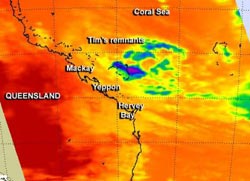NASA sees remnants of Cyclone Tim fading near southeastern Queensland

This infrared image of Cyclone Tim was captured on March 18 at 0355 UTC (March 17 at 11:55 p.m. EDT) by the AIRS instrument aboard NASA's Aqua satellite. The coldest cloud top temperatures and strongest thunderstorms appear in small area of purple off shore from southeastern Queensland.<br><br>Credit: NASA JPL, Ed Olsen<br>
The Atmospheric Infrared Sounder (AIRS) instrument aboard NASA's Aqua satellite captured an infrared image of Cyclone Tim on March 18 at 0355 UTC (March 17 at 11:55 p.m. EDT). The AIRS image showed that cloud top temperatures had warmed significantly since the previous day as the low pressure area continues to weaken. The coldest cloud top temperatures and strongest thunderstorms appeared in small area offshore from southeastern Queensland.
On March 18 at 1200 UTC (8 a.m. EDT/10 p.m. local time, Brisbane, Queensland, Australia), the remnants of ex-cyclone Tim was located near 19.1 south latitude and 151.7 east longitude, was located about 190 nautical miles (218.6 miles/ 352 km) northeast of Mackay. Tim's remnants were drifting west at 2 knots (2.3 mph/3.7 kph). The Australian Bureau of Meteorology (ABOM) noted that Tim's remnants are causing rough to very rough seas and moderate south to southeasterly swell. According to ABOM, wind gusts to 40 knots (46 mph/74 kph) are possible from Tim's remnants.
As a result of Tim's close proximity to the Queensland coast, several warnings were posted on March 18 at 2:15 p.m. EDT/U.S. (12:15 a.m. local time, Brisbane on Tuesday, March 19). A Gale Warning is in effect from Townsville to Bowen and from Bowen to Yeppoon, Strong Wind Warnings are in effect from Cardwell to Townsville and from Yeppoon to Double Island Point, including Hervey Bay. A Coastal Waters Wind Warning was also posted for Cardwell to Double Island Point, including Hervey Bay.
ABOM expects Tim's remnants to move in a west-northwest direction towards the Queensland coast over the next few days.
Media Contact
More Information:
http://www.nasa.govAll latest news from the category: Earth Sciences
Earth Sciences (also referred to as Geosciences), which deals with basic issues surrounding our planet, plays a vital role in the area of energy and raw materials supply.
Earth Sciences comprises subjects such as geology, geography, geological informatics, paleontology, mineralogy, petrography, crystallography, geophysics, geodesy, glaciology, cartography, photogrammetry, meteorology and seismology, early-warning systems, earthquake research and polar research.
Newest articles

Bringing bio-inspired robots to life
Nebraska researcher Eric Markvicka gets NSF CAREER Award to pursue manufacture of novel materials for soft robotics and stretchable electronics. Engineers are increasingly eager to develop robots that mimic the…

Bella moths use poison to attract mates
Scientists are closer to finding out how. Pyrrolizidine alkaloids are as bitter and toxic as they are hard to pronounce. They’re produced by several different types of plants and are…

AI tool creates ‘synthetic’ images of cells
…for enhanced microscopy analysis. Observing individual cells through microscopes can reveal a range of important cell biological phenomena that frequently play a role in human diseases, but the process of…





















